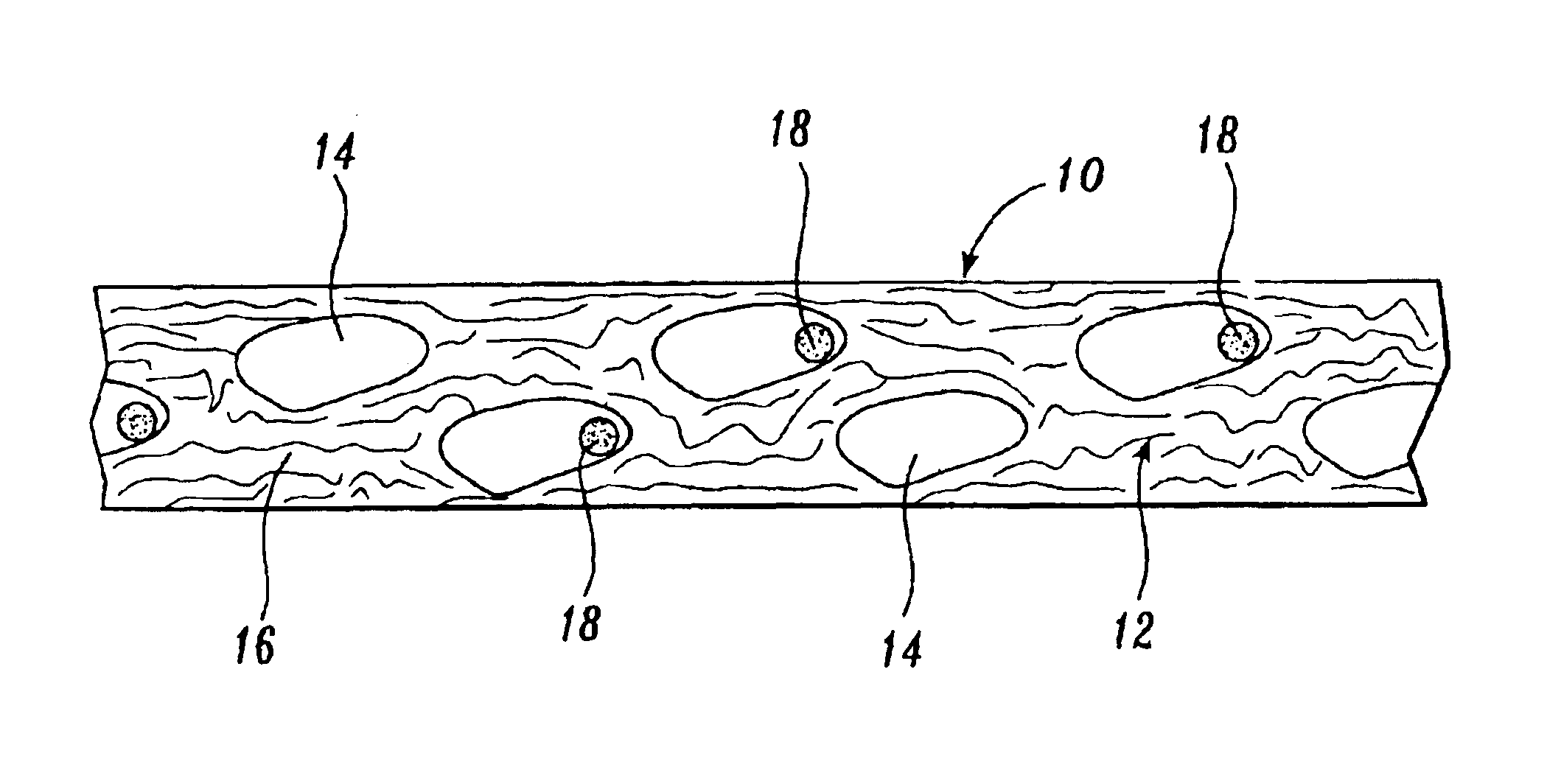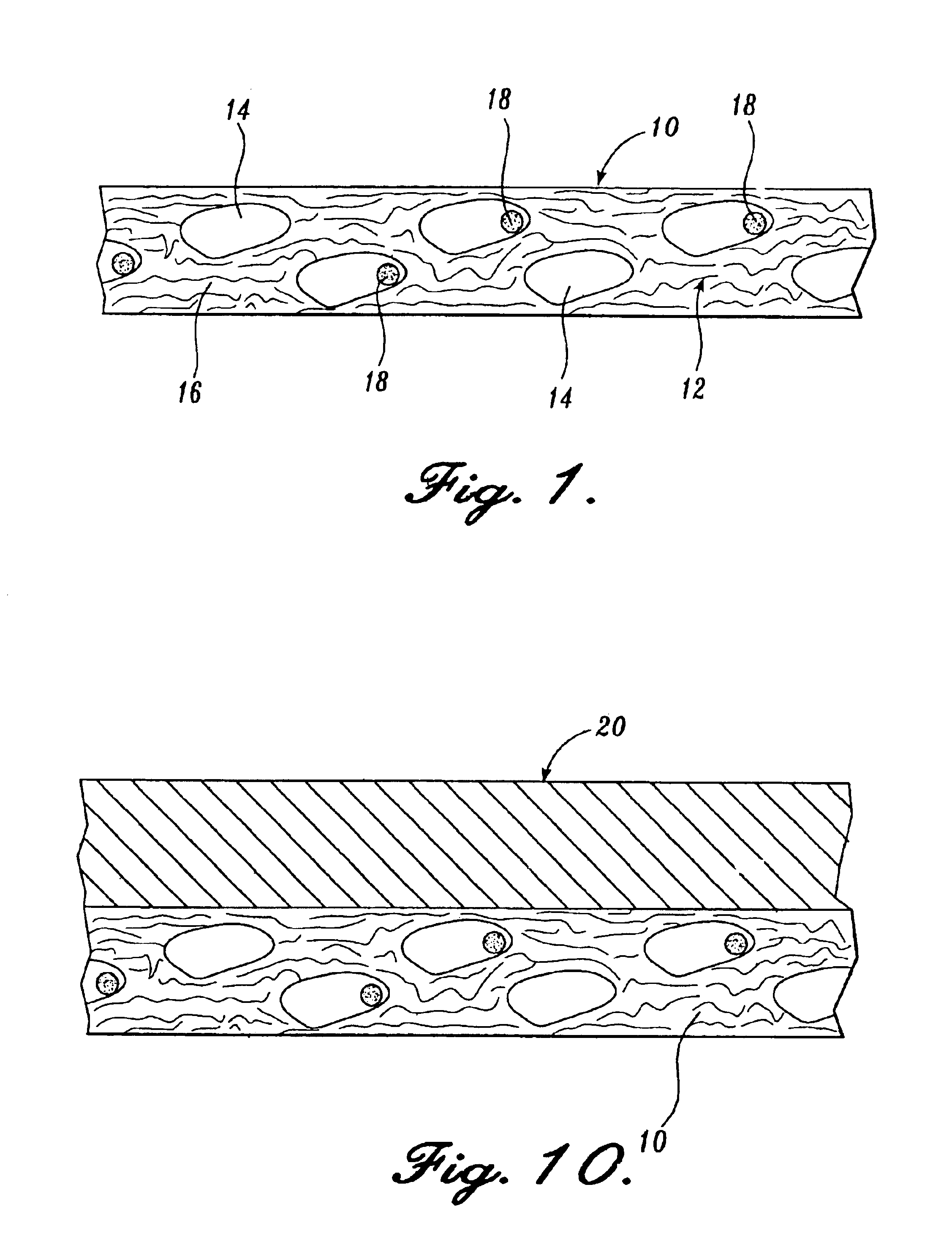Reticulated absorbent composite
a absorbent composite and reticulated technology, applied in the field of absorbent composites, can solve the problems of reducing the size of the absorbent material, forming voids in the absorbent composite, and dehydration of the swollen absorbent material, so as to improve the wicking of liquid, acquisition and distribution, and high absorbent capacity
- Summary
- Abstract
- Description
- Claims
- Application Information
AI Technical Summary
Benefits of technology
Problems solved by technology
Method used
Image
Examples
example 1
Reticulated Absorbent Composite Formation: Representative Wet-laid Method
[0095]This example illustrates a wet-laid method for forming a representative absorbent composite of the present invention.
[0096]A wet-laid composite formed in accordance with the present invention is prepared utilizing standard wet-laid apparatus known to those in the art. A slurry of a mixture of standard wood pulp fibers and crosslinked pulp fibers (48 and 12 percent by weight, respectively, based on total weight of dried composite) in water having a consistency of about 0.25 to 3 percent is formed. Consistency is defined as the weight percent of fibers present in the slurry, based on the total weight of the slurry. A wet strength agent such as Kymene® (0.5 percent based on total composite weight) is then added to the fibrous mixture. Finally, absorbent material (40 percent by weight based on total weight of dried composite) is added to the slurry, the slurry is thoroughly mixed, and then distributed onto a ...
example 2
Reticulated Absorbent Composite Formation:
Representative Foam Method
[0098]This example illustrates a foam method for forming a representative absorbent composite of the present invention.
[0099]A lab-size Waring blender is filled with 4L of water and pulp fibers are added. The mixture is blended for a short time. Crosslinked cellulose fibers are then added to the pulp fibers and blended for at least one minute to open the crosslinked fibers and effect mixing of the two fibers. The resulting mixture may contain from 0.07 to 12 percent by weight of solids.
[0100]The mixture is placed in a container and blended for a few seconds with an air-entrapping blade. A surfactant (Incronan 30, Croda, Inc.) is added to the blended mixture. Approximately 1 g active surfactant solids per gram of fiber is added. The mixture is blended while slowly raising the mixer blade height from the rising foam. After about one minute, the mixing is terminated, superabsorbent is added, and the mixing is restarted...
example 3
Acquisition Times for a Representative Reticulated Absorbent Composite
[0103]In this example, the acquisition time for a representative reticulated absorbent composite of the present invention (Composite A) is compared to a commercially available diaper (Diaper A, Kimberly-Clark).
[0104]The tests were conducted on commercially available diapers (Kimberly-Clark) from which the core and surge management layer were removed and the surrounds used. The test diapers were prepared by inserting the absorbent composite into the diaper.
[0105]The aqueous solution used in the tests is a synthetic urine available from National Scientific under the trade name RICCA. The synthetic urine is a saline solution containing 135 meq. / L sodium, 8.6 meq. / L calcium, 7.7 meq. / L magnesium, 1.94% urea by weight (based on total weight), plus other ingredients.
[0106]A sample of the absorbent structure was prepared for the test by determining the center of the structure's core, measuring 1 inch to the front for liq...
PUM
| Property | Measurement | Unit |
|---|---|---|
| density | aaaaa | aaaaa |
| density | aaaaa | aaaaa |
| density | aaaaa | aaaaa |
Abstract
Description
Claims
Application Information
 Login to View More
Login to View More - R&D
- Intellectual Property
- Life Sciences
- Materials
- Tech Scout
- Unparalleled Data Quality
- Higher Quality Content
- 60% Fewer Hallucinations
Browse by: Latest US Patents, China's latest patents, Technical Efficacy Thesaurus, Application Domain, Technology Topic, Popular Technical Reports.
© 2025 PatSnap. All rights reserved.Legal|Privacy policy|Modern Slavery Act Transparency Statement|Sitemap|About US| Contact US: help@patsnap.com



